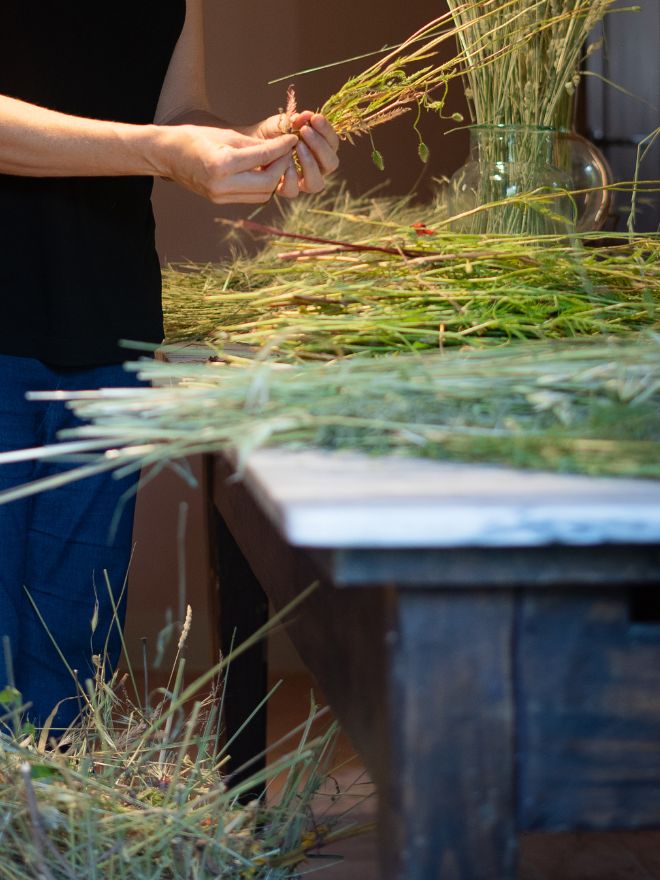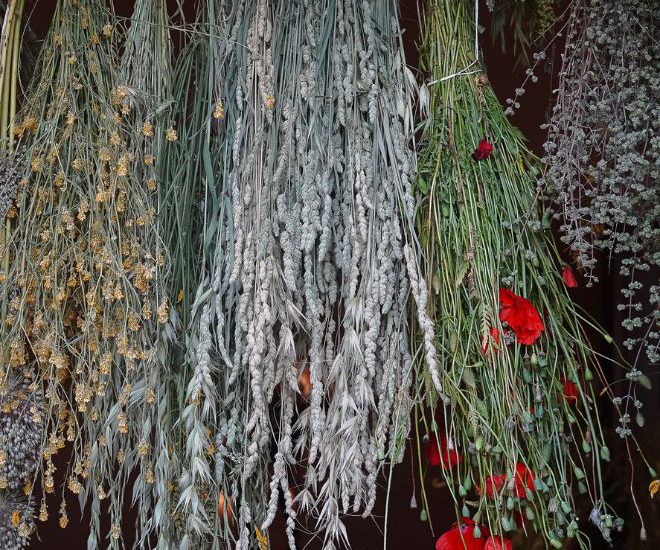In recent weeks, we often see Kate – who is in charge of the workshops at the farm – immersed in the bushes, hunting for flowers and plants of all kinds. We asked her if she has found what she is looking for and how she goes about her exploration of the estate.
Spring and early summer in Tuscany offer an abundance of wildflowers, and I am currently immersed in the delightful task of collecting these vibrant blooms. My aim is to gather a few from each area while ensuring enough remain for the wildlife to enjoy as well.
These dried flowers and plants will be used in various creative workshops throughout the summer. From floral wreath making to ecoprinting, natural dye workshops, decorative bouquets, floral installations, botanical drawing and painting, cyanotype workshops, pressed flower decorations, natural soaps, and tinctures, the uses for these precious resources are as diverse as they are infinite. I am busily filling my stock cupboard, ready for both summer and winter workshops.

Current Wildflower Harvest
At present, I am finding a wonderful variety of flowers, including:
- Daisies
- St. John’s Wort (Hypericum perforatum)
- Allium
- Poppies
- Various seed heads
- Wild Geranium
- Nigella
- Noble Yarrow
- Yellow Sweet Clover
- Egyptian Clover
- Broom (Ginestra)
- Various types of Marguerite or Argyranthemum, including the beautiful Dyer’s Chamomile

The Joy of Discovery
Collecting flowers is not just about gathering materials; it’s an opportunity to connect with nature. Each outing reveals new plants that have just bloomed, showcasing their beauty and potential uses, whether medicinal, decorative, or for dyeing.

Drying Flowers: The Process
There are several methods for drying flowers to preserve their color and beauty. Some use silica, sand, microwaves, or ovens to speed up the process, but my favorite method is air drying.
Air Drying: This is the easiest and most natural method. Simply hang the plants upside down in a warm, dark, airy room. After collecting your plants, remove as many leaves as possible from the stems and tie small bunches together. Keep them away from harsh sunlight to ensure they dry slowly and retain their color. Rotate the flowers during this process to help them retain their shape. For larger flowers like roses or peonies, it’s best to hang them individually to maximize airflow, reduce mold risk, and maintain their shape.

Solar Bleaching: If you prefer a sun-bleached look, you can dry certain plants in direct sunlight. Many florists bleach their flowers and grasses to lighten their color, but the sun can achieve this naturally. I often use this method for drying hardy grasses.
Drying Flowers for Dye: When drying flower heads for later use as a dye, remove the heads and dry them thoroughly in a well-ventilated, shaded area. Any remaining moisture can cause mold. Once dry, store the flower heads in an airtight container until ready to use.
Pressed Flowers: An Ancient Artform
Pressing flowers is another ancient and straightforward method of preserving and documenting plants. Trim the flower or plant to make it as flat as possible, then press it firmly between absorbent papers under weighted sheets of wood. This technique offers countless creative possibilities throughout the year.
Embracing the Abundance of Nature
Collecting and preserving wildflowers during their spring abundance is not only a pleasure but also a wonderful way to become familiar with local flora and fauna. Each day brings new discoveries and opportunities to learn and appreciate the natural world around us.


